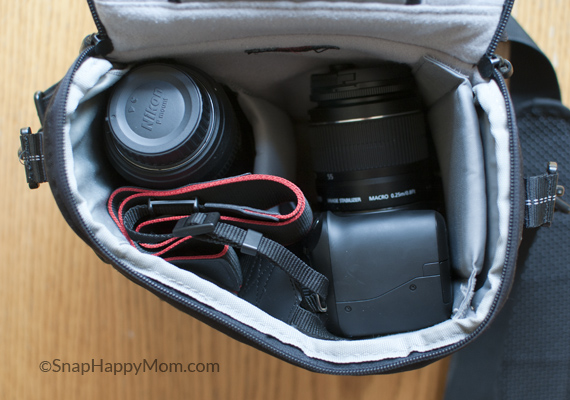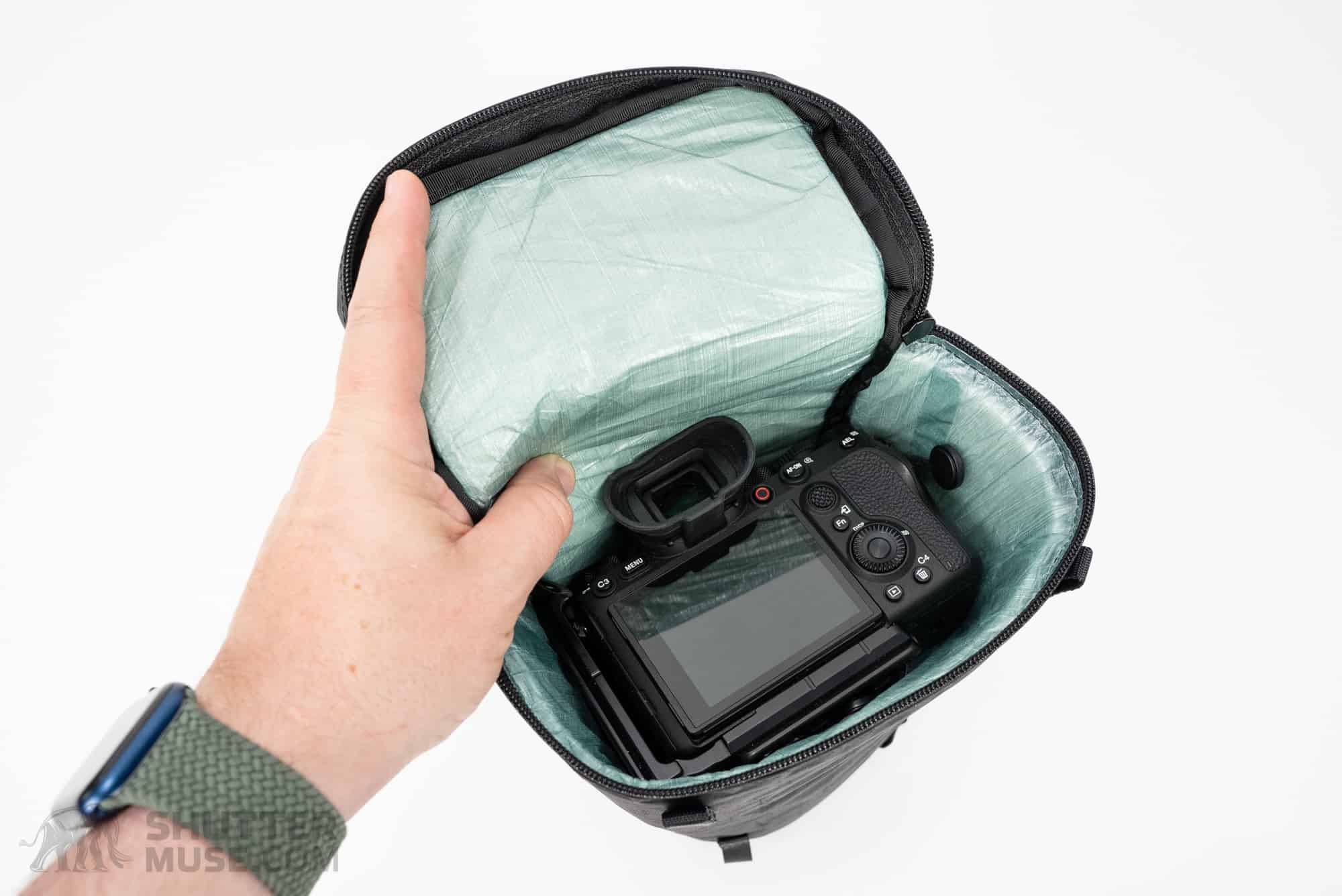Placing a camera in a camera bag might seem simple. Yet, it’s crucial to do it right.
Proper placement protects your gear and makes it easy to access. A camera is an investment, and its safety is important. Knowing how to store it in a camera bag helps avoid damage and makes travel easier. With various compartments and padding, a good camera bag offers security.
It’s about finding the balance between protection and convenience. This guide will explore the best ways to position your camera within its bag. You’ll learn how to use the bag’s features effectively. Whether you’re a professional or a hobbyist, understanding this process is key to ensuring your camera’s longevity. Let’s delve into the steps to secure your camera safely in its bag.

Credit: snaphappymom.com
Table of Contents
Choosing The Right Camera Bag
Camera bags come in different shapes and sizes. You can choose a backpack, sling bag, or messenger bag. Backpacks are great for carrying lots of gear. Sling bags are easy to access quickly. Messenger bags are stylish and compact. Consider your needs and the amount of gear you carry.
A good camera bag should have padding to protect your gear. Adjustable dividers help organize cameras and lenses. Look for water-resistant material to keep equipment safe. Comfortable straps make carrying easy. A sturdy handle is useful for quick grabs. Ensure the bag has enough space for accessories. Zippered pockets are ideal for small items. Velcro straps can secure tripods outside the bag.

Credit: www.kentfaith.com
Preparing Your Camera Gear
Keep your camera clean. Remove dust using a soft brush. Wipe lenses with a clean cloth. Use lens cleaner for spots. Check the camera body for dirt. Clean gently to avoid scratches. Dust can harm your camera. Dirty lenses blur photos. Regular cleaning keeps the camera safe. Clean equipment before storing in the bag.
Place items neatly in your bag. Use small pockets for batteries. Store memory cards safely. Keep charger in a separate pocket. Wrap cables to prevent tangles. Arrange lenses carefully. Protect fragile items with padding. Organized gear helps find things fast. A tidy bag saves time. Check each pocket for missing items.
Arranging The Camera
The camera body should go in the bag first. Keep it in the main compartment. This gives it the most protection. Make sure it is centered in the space. Use padded dividers if you have them. This stops the camera from moving. It also keeps it safe from bumps and scratches.
Lenses need careful handling. Place them next to the camera body. Use lens caps to cover them. This keeps dust away. Secure them with padded dividers. This ensures they do not move. Check that they are snug but not too tight. Avoid pressure on the glass.
Storing Additional Lenses
Careful placement ensures extra lenses are secure in your camera bag. Use padded dividers to protect lenses from scratches. Arrange lenses vertically, keeping them separated to avoid damage during transport.
Using Lens Pouches
Lens pouches are soft and protective. They keep lenses from scratches. Choose pouches that fit snugly. This prevents movement. Secure the pouch in the camera bag. It avoids accidental falls. Velcro or zippers help keep lenses safe. Pick waterproof pouches for rainy days. These protect lenses from water. Always check the pouch for wear. Replace it if damaged. Pouches should be padded. This adds extra safety. Keep lenses clean before storing. It helps maintain lens quality.
Positioning Lenses Safely
Position lenses vertically in the bag. Use dividers to separate them. This prevents lens collisions. Place heavier lenses at the bottom. It balances the bag. Secure lenses with straps. They reduce movement. Check for loose items in the bag. They can cause damage. Arrange lenses with care. Keep lens caps on. It protects the glass. Make sure the bag is zipped up. This avoids accidental spills. Always handle lenses gently.
Packing Camera Accessories
Keep your memory cards in a small, safe case. This case must be easy to find. Label each card with a marker. This helps to know what’s on them. Use a bright case color. You won’t lose it in the bag.
Put your batteries in a separate bag. This bag must be soft inside. It keeps them safe. Chargers should be wrapped in a cloth. This stops them from breaking. Make sure everything is in reach. You will need them often.
Utilizing Bag Compartments
Adjustable dividers help keep your camera safe. Dividers can be moved to fit your camera. This allows you to use different compartments for lens and gear. Adjust them to fit snugly around your camera. Make sure everything is secure before closing the bag.
Use small compartments for accessories. Space in the bag can be increased this way. Lenses, batteries, and cables fit well here. Organize them carefully to avoid clutter. Always ensure each item has a place. Check that nothing is loose before moving.
Ensuring Protection And Security
Cameras are delicate tools. They need special care. Use thick padding inside the camera bag. This keeps the camera safe from bumps. Soft materials like foam or fabric work best. Foam protects the camera well. It absorbs shocks. A camera with good padding will stay safe.
Adjust the padding to fit your camera snugly. Make sure all sides are covered. This helps avoid scratches. Extra pockets can store lenses and batteries. These must also have padding. A well-padded bag protects all camera parts.
Security is important for cameras. Use locks on your camera bag. A lock stops others from opening the bag. It keeps the camera safe. Choose a lock that is easy to use. Locks should be strong and durable.
Some bags come with built-in locks. These can be very useful. If your bag has no lock, buy a small padlock. Always keep your bag close. A camera is safe when the bag is locked. Security gives peace of mind.
Carrying And Travel Tips
A camera bag should feel comfortable. Place heavy items at the bottom. This helps keep balance. Use the padded dividers. They keep things from moving. Balance the weight on both sides. This makes the bag easier to carry. You won’t feel lopsided. Your back will thank you.
Keep your most used items at the top. This includes your camera and main lens. Use pockets for small items. Memory cards and batteries fit well there. Try to remember where things are. This will help you grab them fast. No need to dig through the bag. Time is saved. Stress is reduced.

Credit: shuttermuse.com
Frequently Asked Questions
Can I Put My Camera In My Personal Bag?
Yes, you can place your camera in your personal bag. Ensure it’s securely packed to avoid damage. Consider using a padded case for protection. Airlines generally allow electronic devices in carry-on bags. Always check specific airline policies for any restrictions.
How To Pack A Camera For Travel?
Use a padded camera bag to protect your gear. Store lenses and accessories separately. Securely wrap each item. Place silica gel packs to prevent moisture. Keep the bag in your carry-on to avoid damage.
How Do You Attach A Camera To A Backpack?
Use a camera clip or strap to secure your camera to the backpack. Attach it to shoulder straps or loops. Ensure it’s tightly fastened for stability and safety. Consider using padded cases for extra protection. Check the compatibility of your camera and backpack before purchasing accessories.
How To Carry A Camera While Backpacking?
Use a padded camera bag or insert for protection. Attach it to your backpack straps for easy access. Secure it with a waterproof cover during rain. Keep extra batteries and memory cards in a separate pocket. Always use a neck strap or wrist strap for safety.
Conclusion
Packing your camera bag correctly ensures gear safety and readiness. Always choose a bag with adjustable compartments. Place the camera body in the main section. Lenses should go in padded slots. Keep accessories in side pockets for easy access. Remember, secure your equipment to avoid damage during travel.
Proper organization saves time during shoots. Practice makes the process smoother. Follow these tips to protect your camera gear. With care, your equipment stays in top shape. Enjoy capturing memories without worry. Now, you’re ready to hit the road with confidence and creativity!